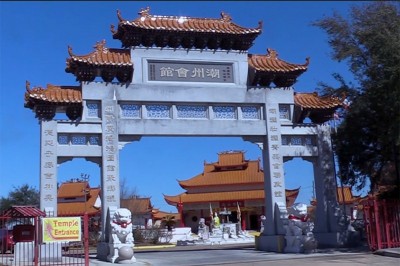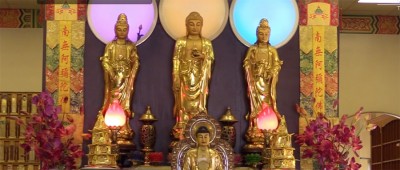
An exotic building in the International Management District overflows with symbols.
And the site is a treasure in another way: Chinese and Vietnamese cultures are distinct, but this is a place where they visually overlap.
Teo Chew Temple, at 10599 Turtlewood Court, is a public place for worship and reflection.
Many of the local founders of the Buddhist temple came from Vietnam. But many people would associate its images with Chinese decor.
 Carved dragons “protect” the temple roof, which is curved to ward off evil spirits. Statues of lions frame the doors, symbolizing protective strength. Inside, red surfaces stand for
Carved dragons “protect” the temple roof, which is curved to ward off evil spirits. Statues of lions frame the doors, symbolizing protective strength. Inside, red surfaces stand for
joy, vitality, celebration and good luck. Gold colors stand for wealth.
You can get a vivid introduction to it all in a narrated 6-minute video by clicking here.
Marking the Chinese New Year in February, the Asia Society Texas Center created brief videos like that one to help viewers explore some of the wonders of Chinatown.
Now the Houston Mayor’s Office of Cultural Affairs has granted funds to the Center to dive into such cultural gems at greater length. The Center plans to create “virtual” (online) bus tours of the Chinatown corridor for presentation to assembled groups with an in-person guide and perhaps a live lesson in Chinese calligraphy or other traditions with deep cultural roots.
“For people who never set foot in the (Bellaire Boulevard corridor) before, the idea is to bring them back on their own with a list of places to visit,” said Cathy Podell, education and outreach coordinator for Asia Society Texas Center.
The city grants, funded by the city’s hotel occupancy tax, are aimed at boosting the city’s post-pandemic economic recovery by focusing on factors such as “neighborhood cultural destinations.”
“Houstonians can explore their neighborhoods and city with a fresh lens, as if they were tourists within their own city,” Mayor Sylvester Turner said.
 At the Teo Chew Temple, being a tourist from near or far includes looking at an outdoor fountain decorated with statues of the 12 animals that make up the Chinese zodiac: Ox, rat, tiger, rabbit, dragon, snake, horse, goat, money, rooster, dog and pig. Ox comes first for now because this is the Chinese Year of the Ox.
At the Teo Chew Temple, being a tourist from near or far includes looking at an outdoor fountain decorated with statues of the 12 animals that make up the Chinese zodiac: Ox, rat, tiger, rabbit, dragon, snake, horse, goat, money, rooster, dog and pig. Ox comes first for now because this is the Chinese Year of the Ox.
Inside, worshippers seeking help on their spiritual journeys leave fruit and incense, and oil to fuel candles — all as offerings to Chinese gods.
There are two other units on the grounds: A shrine to ancestors and a Chinese language school.







Leave A Comment